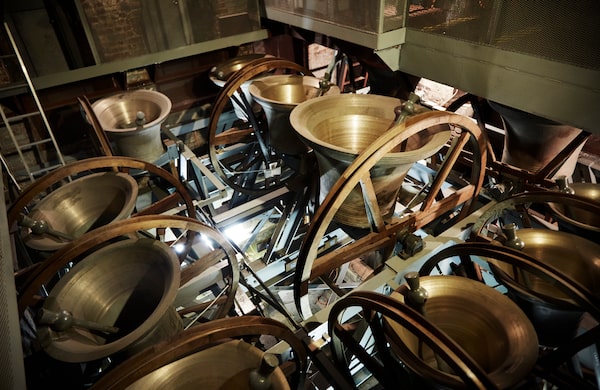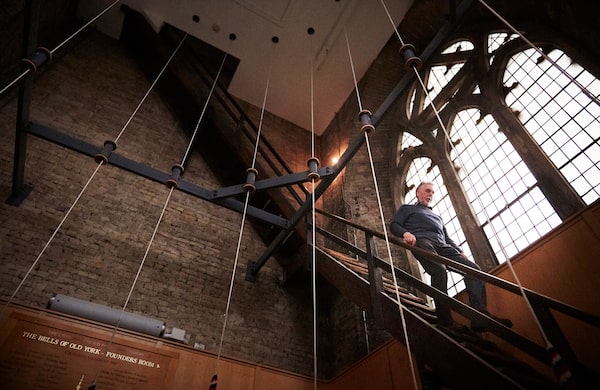
David Wilcox, second from left, is the Ringing Master at St. James Cathedral in Toronto.Thomas Bollmann/The Globe and Mail
On any given Sunday, 93 metres above street level, you can find David Wilcox ringing the bells of Toronto’s St. James Cathedral.
Born in Reading, England, Mr. Wilcox started “change ringing” when he was a teenager, more than 50 years ago.
At St. James, he is the Ringing Master, a prestigious position among a small but dedicated global community of bell ringers.
Though people may imagine a lone bell ringer, like the fictional Quasimodo, in fact, Mr. Wilcox is part of a group that shares his passion for ringing, if not his expertise.
Change ringing is a method of sounding bells in a series of memorized patterns that change, requiring the ringers to master subtle changes in how they pull the bell ropes, and close teamwork with the other ringers.
It can take anywhere from three to 12 months to learn to ring the bells if you practice, but you never really master it, Mr. Wilcox says.

The bells are mounted on wooden wheels in a room above where the bell ringing ropes hang at St. James Cathedral in Toronto.Thomas Bollmann/The Globe and Mail
“Many of us feel we’re always learning, no matter how long we’ve been ringing,” says Mr. Wilcox, who is 72.
But learning the technique is only a passport to experiencing something more profound, he adds.
“It’s music – but you don’t have to be a musician,” he says. “It’s like listening to a choir or an orchestra.”
An English tradition that dates back to the 1600s, bell ringing is a skill everyone is welcome to learn, regardless of faith or even age – Mr. Wilcox’s youngest student is 11 years old.

Ropes for the ringers to pull descend from the bells into the ringing room below.Thomas Bollmann/The Globe and Mail
“I teach because I want to pass on the skill to the next generation, as I find it so rewarding,” he says.
St. James Cathedral is only one of two churches in North America with 12 change ringing bells. They are heavy, bronze bells hung in such a way as to allow the ringers to execute their patterns. The other church is Trinity in New York City, where Mark and Elaine Gosden are regulars, despite a one-hour commute from their Connecticut home.
The Gosdens first met in a ringing chamber in London and became such diehard ringers that when their son, Sam, was born, they headed straight to a ringing practice from the hospital.
Change ringing involves sounding bells in a series of memorized patterns that shift, requiring the ringers to master subtle changes in how they pull the bell ropes
“He loves that story because he’s now quite a good ringer,” says Mark.
In 1997, when the changing bells were installed at St. James to mark the 200th anniversary of the cathedral’s founding, the Gosdens attended the inauguration, along with the Queen, who dedicated the bells.
The couple makes the trek to Toronto to ring at least once a year; last fall, it was to a North American Guild of Change Ringers annual meeting.
“I started in England when I was 10,” says Elaine, an engineer. “When I got to university, I joined a ringers society.”
Mark, an accountant, got hooked in his 20s. “I joined the ringers to have a social life and ended up going to ringing practice five nights a week.”
Considering the biggest bell – the tenor – weighs about as much as a Honda Civic, one might expect that a certain heft would be an advantage, but Mr. Wilcox insists it’s not a physically taxing job.
“A bell will naturally swing through 85 per cent of the circle on its own if you just let it go,” he explains, “so the bell does most of the work. Our job is to control it.”
The bells, hung at the very top of the tower are attached by the headstock to a wooden wheel with a channel for the rope to run along.

A series of patterns for the change ringing method of sounding bells, requiring the ringers to master subtle changes in how they pull the bell ropes, and work closely with the other ringers.Thomas Bollmann/The Globe and Mail
The rope eventually drops down through a hole in the floor, and into the hands of the ringers, numbering from just a few to 12, who stand in a circle in the ringing chamber below.
Change ringing bells are pulled into a balanced position with the mouth of the bell turned upwards. From that balanced position, the bell swings back and forth 360 degrees. It strikes each time it nears that top position.
The bells ring in continuously changing patterns, not melodies or tunes. These patterns are either memorized, or the changes in patterns are called out by a ringer known as the conductor. The changes have names like Plain Bob and Double Oxford.
Listening to the bells and watching the other ringers is essential to following where one is in the sequence.
A peal of bells can last more than three hours, while the more common quarter peal is about 45 minutes.
Mr. Wilcox is happy to arrange bell peal weekends, but says the lack of experienced ringers is a challenge.

After sounding the bells, the ringers have yet more exercise, as it takes another series of stairs to descend from the bell ringing room at St. James Cathedral.Thomas Bollmann/The Globe and Mail
“In England you have 5,000 churches with these kinds of bells,” he says. “We don’t have that luxury of experience here.”
But despite the drawbacks, Mr. Wilcox says he’s optimistic that new ringers will emerge. He notes the draw of a strong community, both local and international in nature. Whether ringers gather at the pub to cap a session of ringing, or whether they choose to go farther afield, this specialized skill can take them anywhere.
“You can ring in virtually any tower in the world,” he says. “You are always welcomed with open arms.”
/arc-anglerfish-tgam-prod-tgam.s3.amazonaws.com/public/U6I4YIQNDVFUZEDSRT75BNAM3E.jpg)
/arc-anglerfish-tgam-prod-tgam.s3.amazonaws.com/public/V7E7IHOE5NDV5MZAAM45PSRU5Y.jpg)
/arc-anglerfish-tgam-prod-tgam.s3.amazonaws.com/public/ISPCSVFBVVBUVJTVTY5XR35BJ4.jpg)